SMART goals provide a structured approach to goal setting, ensuring that objectives are Specific, Measurable, Achievable, Relevant, and Time-bound. This guide will walk you through the concept of SMART goals, and their importance in the workplace, and provide you with free examples and a step-by-step guide to writing your own SMART goals. By the end of this article, you'll be equipped with the knowledge and tools to set effective goals that drive progress and productivity in your professional life.
What is a Smart Goal Example?

A SMART goal example is a well-defined objective that follows the SMART criteria: Specific, Measurable, Achievable, Relevant, and Time-bound. Each component of the SMART framework ensures that the goal is clear and reachable, with a defined timeline for completion. Here’s a breakdown of each component:
Specific: The goal should be clear and specific, answering the who, what, where, when, and why.
Measurable: The goal should include criteria to track progress and measure the outcome.
Achievable: The goal should be realistic and attainable, considering available resources and constraints.
Relevant: The goal should align with broader objectives and be relevant to your professional or personal aspirations.
Time-bound: The goal should have a clear deadline or timeframe to create a sense of urgency and focus.
Why Use Smart Goal Example for Work?
Using SMART goal examples in the workplace offers numerous benefits, helping individuals and teams to stay focused, motivated, and aligned with organizational objectives. Here are some key advantages:
Clarity and Focus: SMART goal examples provide clear direction, helping employees understand exactly what is expected of them.
Motivation and Commitment: Well-defined goals increase motivation and commitment by setting clear expectations and milestones.
Enhanced Performance: Specific and measurable goals facilitate better performance tracking and improvement.
Efficient Resource Allocation: SMART goals help in identifying and allocating resources more effectively, ensuring that efforts are focused on priority areas.
Better Time Management: Time-bound goals promote better time management by creating deadlines and urgency.
Alignment with Organizational Objectives: SMART goals ensure that individual efforts are aligned with the broader objectives of the organization, fostering a cohesive and focused work environment.
5 Free Smart Goal Examples for Work
Here are five detailed examples of SMART goals tailored for different professional scenarios. These examples illustrate how the SMART criteria can be applied to various work-related objectives.
1. Increasing Sales Performance
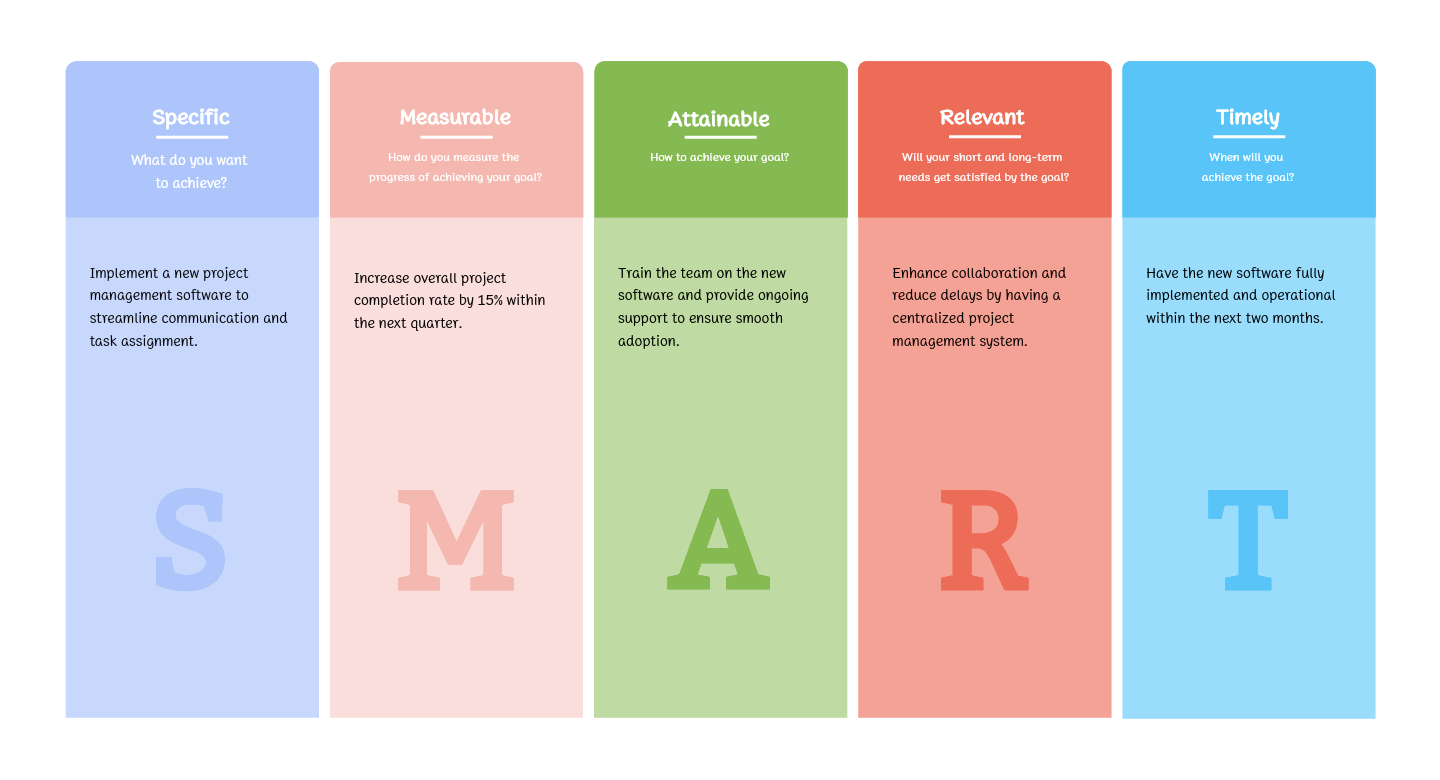
Goal:
Specific: Increase monthly sales revenue by 15% through targeted marketing campaigns and improved sales techniques.
Measurable: Use sales data and performance metrics to track the increase in revenue. Achievable: Based on market analysis and past performance, a 15% increase is attainable with the proposed strategies.
Relevant: This goal supports the company’s objective to expand market share and increase profitability.
Time-bound: Achieve the sales increase within six months.
Application:
Sales teams can implement this goal by designing and executing targeted marketing campaigns, providing sales training to improve techniques, and regularly reviewing sales data to track progress and adjust strategies as needed.
2. Improving Customer Service

Goal:
Specific: Improve customer satisfaction scores by 20% through enhanced training programs and improved response times.
Measurable: Monitor customer satisfaction surveys and feedback to measure improvement. Achievable: With dedicated training and process improvements, a 20% increase is realistic. Relevant: This goal aligns with the company’s commitment to customer excellence and retention.
Time-bound: Achieve the improvement within the next quarter.
Application:
Customer service departments can focus on providing additional training for staff, streamlining response processes, and implementing feedback mechanisms to continually improve service quality.
3. Enhancing Employee Engagement
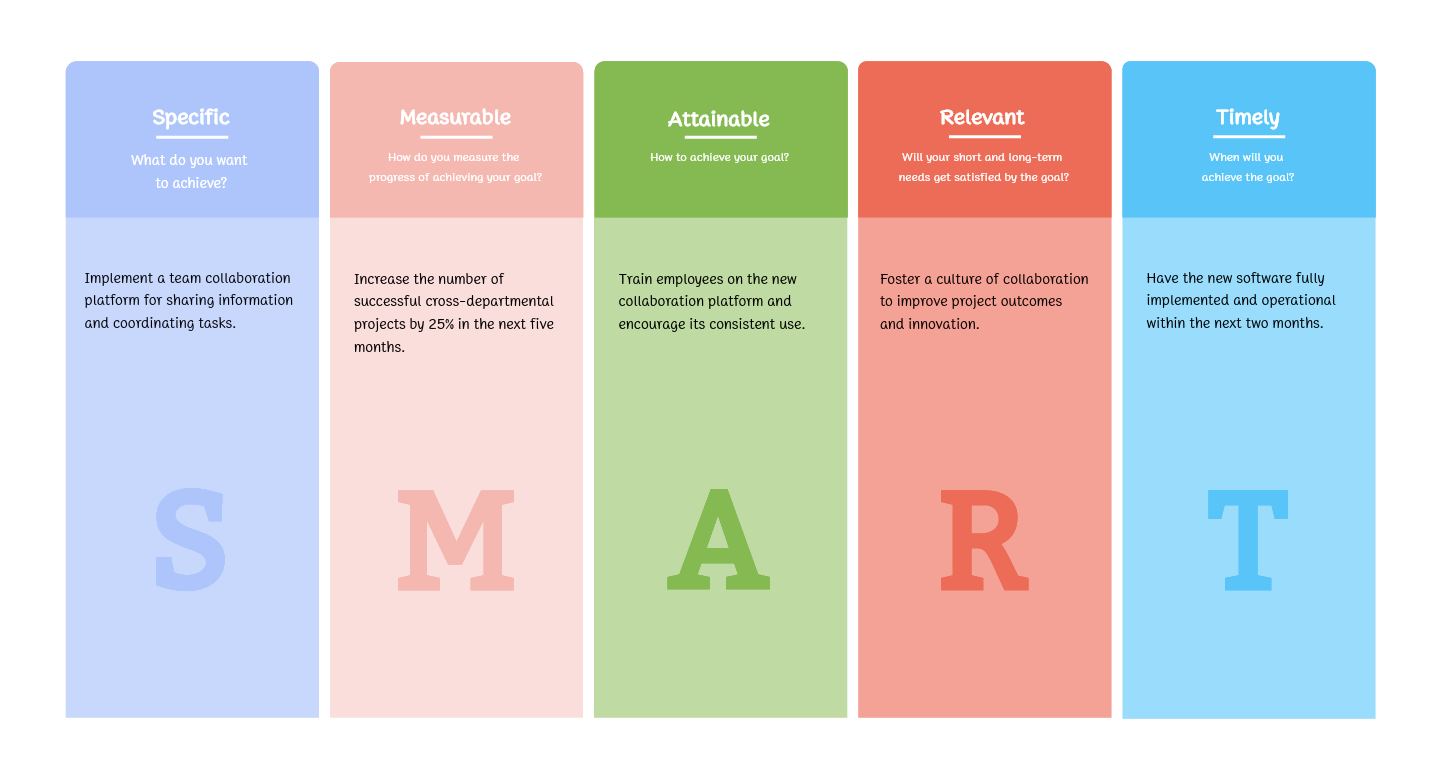
Goal:
Specific: Increase employee engagement scores by 25% through new recognition programs and regular team-building activities.
Measurable: Use employee engagement surveys to track changes in engagement levels. Achievable: Introducing effective recognition programs and team-building activities can realistically boost engagement.
Relevant: This goal supports the organization’s aim to foster a positive and productive work environment.
Time-bound: Achieve the increase within one year.
Application:
HR departments can develop and launch recognition programs, organize team-building events, and conduct regular engagement surveys to monitor progress and adjust initiatives.
4. Streamlining Processes

Goal:
Specific: Reduce project turnaround time by 30% through process optimization and the adoption of new project management tools.
Measurable: Track project completion times to measure the reduction.
Achievable: By optimizing processes and implementing efficient tools, a 30% reduction is feasible.
Relevant: This goal aligns with the company’s focus on efficiency and productivity.
Time-bound: Achieve the reduction within nine months.
Application:
Project management teams can review and optimize current processes, adopt new tools like Boardmix for better project tracking, and continuously evaluate and refine workflows to enhance efficiency.
5. Increasing Digital Presence
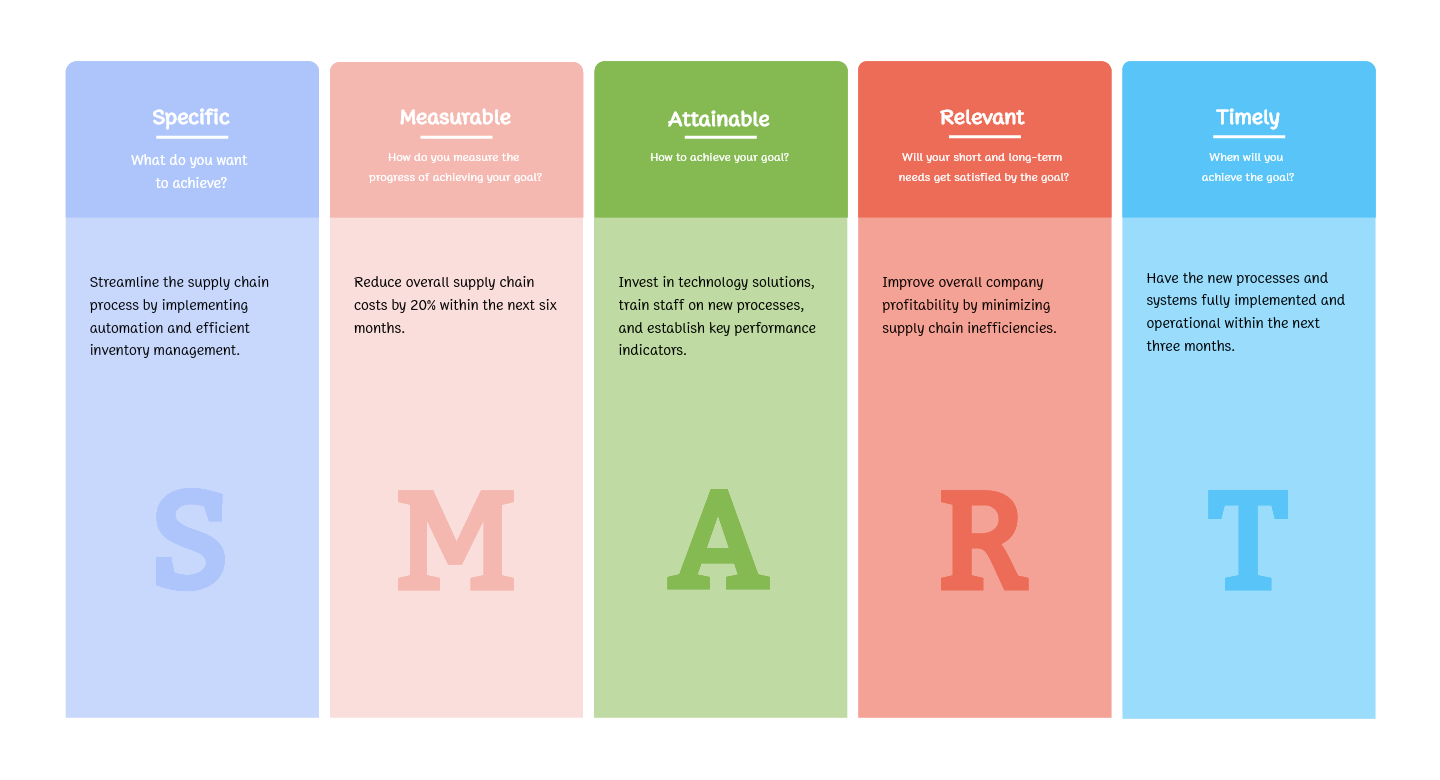
Goal:
Specific: Increase website traffic by 50% through SEO optimization, content marketing, and social media engagement.
Measurable: Use website analytics tools to track traffic increases. Achievable: Given the current digital trends and resources available, a 50% increase is attainable.
Relevant: This goal supports the company’s digital marketing strategy and online growth objectives.
Time-bound: Achieve the traffic increase within eight months.
Application:
Marketing teams can implement SEO best practices, create engaging content, and leverage social media platforms to drive traffic to the company website. Regular monitoring and analysis will ensure strategies are effective.
How to Write a Work Smart Goal Example?
Creating SMART goals for work involves a structured approach to ensure that goals are clear, achievable, and aligned with organizational objectives. Here’s a step-by-step guide to writing effective SMART goals:
1. Define the Specific Goal
-Clearly articulate what you want to achieve. Be precise about the objective, ensuring it addresses the who, what, where, when, and why.
-Example: “Increase the customer retention rate by improving follow-up procedures.”
2. Make the Goal Measurable
-Determine how you will measure progress and success. Include specific criteria or metrics that will help track achievement.
-Example: “Track customer retention rates monthly and aim for a 10% improvement over the next quarter.”
3. Ensure the Goal is Achievable
-Set realistic and attainable goals considering available resources, time, and constraints. Evaluate whether the goal is within reach.
-Example: “Implement a new customer follow-up system and provide training to the sales team to ensure proper use.”
4. Ensure the Goal is Relevant
-Align the goal with broader organizational objectives and ensure it is relevant to your role or department.
-Example: “This goal supports the company’s objective to enhance customer satisfaction and loyalty.”
5. Set a Time-bound Deadline
-Establish a clear timeframe or deadline for achieving the goal. This creates a sense of urgency and helps prioritize efforts.
-Example: “Achieve a 10% improvement in customer retention within the next three months.
Leveraging Boardmix for SMART Goal Creation
Boardmix is an excellent tool for creating and managing SMART goals. Its collaborative features and extensive template library make it easy to set, track, and achieve your objectives. Here’s how to use Boardmix to create a SMART goal:
1. Choose a SMART Goal Template
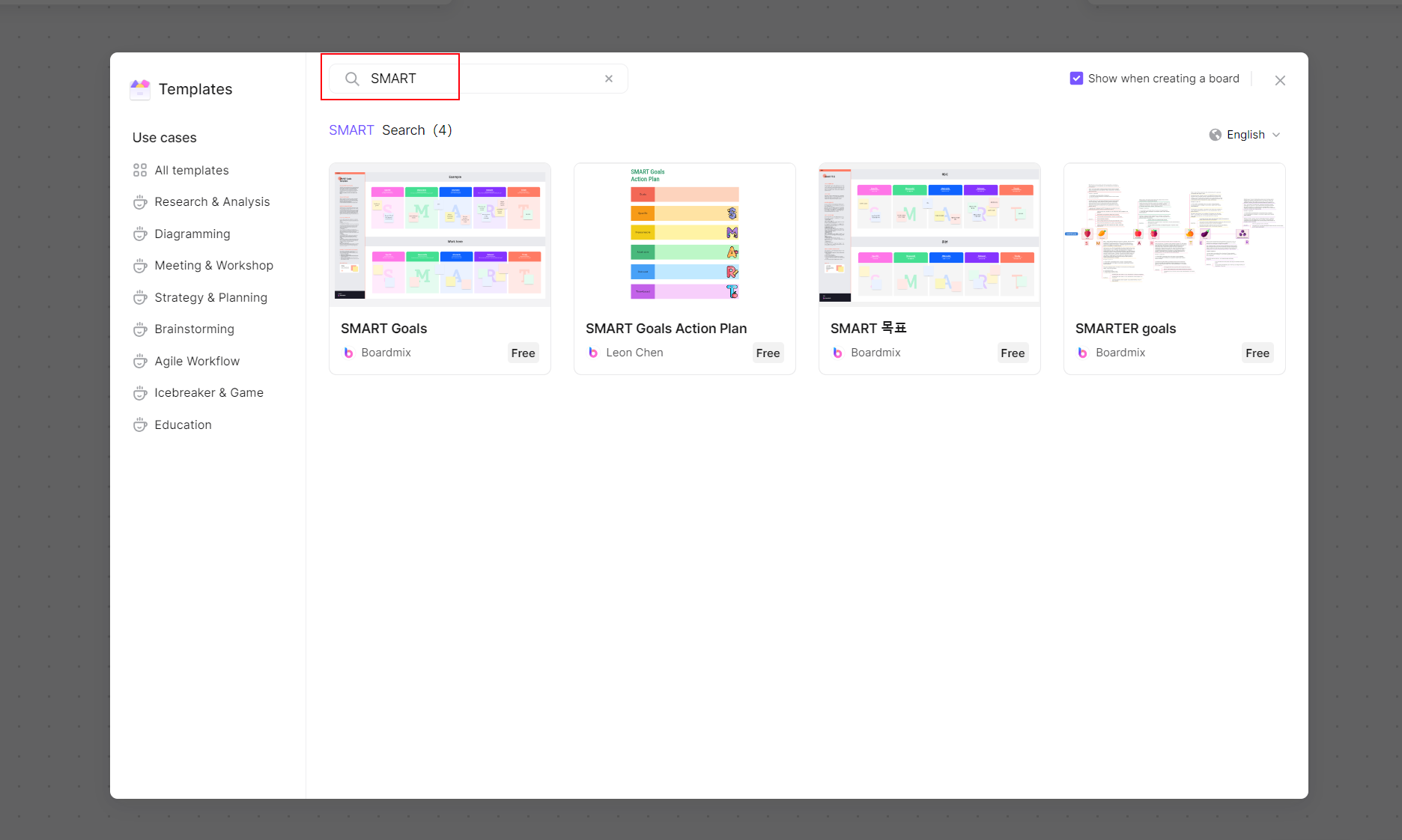
Once logged in, navigate to the template library by clicking on the “Templates” section in the main menu, and Browse through the available templates, and select one that fits your needs. Boardmix offers a variety of templates designed to accommodate different goal-setting scenarios.
2. Customize the Template
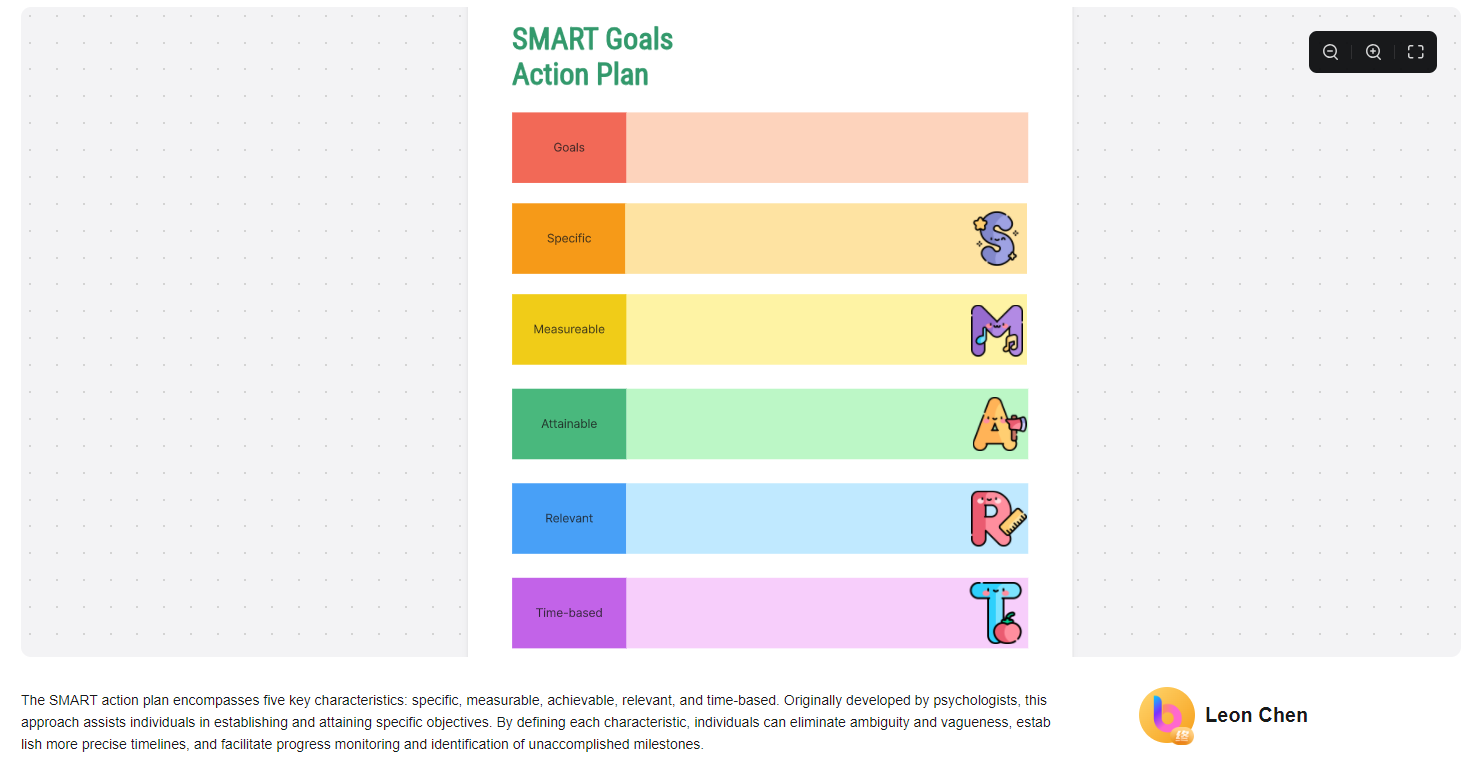
Replace the placeholder text with your specific goal details, ensuring each element of the SMART framework is addressed:
-Specific: Clearly define what you want to achieve.
-Measurable: Determine how you will measure progress and success.
-Achievable: Ensure the goal is realistic and attainable.
-Relevant: Make sure the goal aligns with broader objectives.
-Time-bound: Set a clear timeframe or deadline.
3. Collaborate with Team Members
Click on the “Share” button to invite team members to collaborate on the SMART goal. Team members can access the template and contribute to the goal-setting process in real time. Use Boardmix’s commenting and chat features to discuss and refine the goal details collaboratively.
4. Track Progress:
Use Boardmix’s project management features to set and track milestones related to your SMART goal. Regularly review the progress of your SMART goal and make adjustments if necessary.
SMART goals are essential tools for personal and professional development, providing clarity, direction, and motivation. By understanding and applying the SMART criteria, you can set effective goals that drive success and productivity in your workplace. Utilize the examples and steps provided in this guide to craft your own SMART goals, and leverage tools like Boardmix to enhance your goal-setting process. Start setting SMART goals today and take a significant step towards achieving your professional aspirations.








